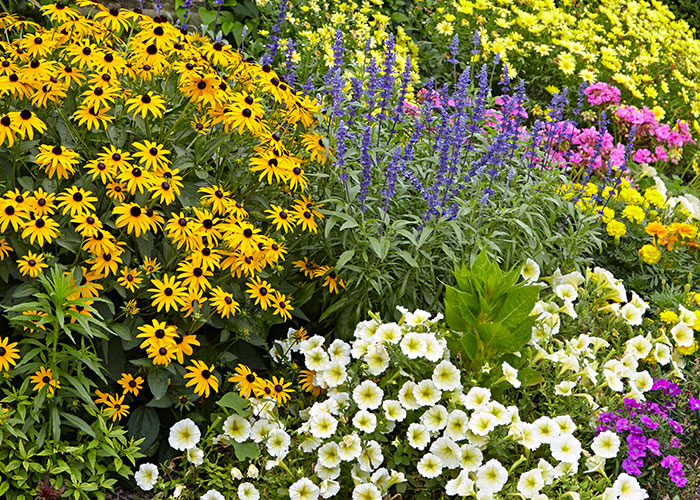
7 Easy Ways to Make Your Garden More Pollinator-Friendly
As the days grow shorter and the leaves begin their vibrant dance, our gardens prepare for a period of rest. But before we settle in with cozy blankets and mugs of steaming cider, let's make sure our green spaces are havens for the vital pollinators that sustain them! From buzzing bees to flitting butterflies, these tiny creatures play a crucial role in our ecosystem. By making a few simple changes, you can transform your backyard into a thriving pollinator paradise. In this post, we'll explore seven easy ways to attract these beneficial insects and ensure a bountiful harvest for years to come. Get ready to roll up your sleeves, grab your gardening gloves, and let's get started!
1. Plant a Pollinator Smorgasbord
The key to attracting a diverse range of pollinators is to offer a variety of food sources. Think of it as setting a beautiful buffet! Pollinators are attracted to different colors, shapes, and blooming times, so aim for a mix of plants that flower throughout the growing season.
- Spring: Crocuses, hyacinths, and early-blooming wildflowers provide essential sustenance for pollinators emerging from their winter slumber.
- Summer: Echinacea (coneflowers), lavender, bee balm, and sunflowers offer a long-lasting feast for bees, butterflies, and hummingbirds.
- Fall: Asters, sedum, and goldenrod provide a crucial late-season food source for pollinators preparing for winter.
Don't be afraid to experiment! I remember one summer when my zucchini plants weren't producing much fruit. After adding a patch of borage nearby, which attracted a swarm of bees, my zucchini yield exploded!
2. Choose Native Plants
Native plants are perfectly adapted to your local climate and soil conditions, making them easier to grow and more appealing to native pollinators. They often require less water and fertilizer than non-native species, making them a sustainable choice for your garden.
A simple way to achieve this is to check with your local nurseries or Cooperative Extension office. They can provide recommendations for native plants that thrive in your area and attract specific pollinators. For example, in the Midwest, milkweed is a crucial host plant for monarch butterflies, while in the Southwest, desert wildflowers provide vital resources for native bees.
3. Ditch the Pesticides (Embrace Organic Gardening)
Pesticides, even those labeled "organic," can be harmful to pollinators. These chemicals can kill beneficial insects directly or disrupt their navigation and foraging abilities. A sustainable home starts with a healthy garden.
Instead of relying on pesticides, embrace organic gardening practices. Encourage beneficial insects like ladybugs and lacewings to control pests naturally. Companion planting, such as planting marigolds among your vegetables, can also deter pests. I always say, a healthy plant is a resistant plant. Make sure your soil is healthy by adding compost regularly.
4. Create a Water Source
Pollinators need water just like any other living creature. Providing a shallow water source can be a lifesaver, especially during hot, dry weather.
A simple way to achieve this is to fill a shallow dish with water and add pebbles or marbles for pollinators to land on. This prevents them from drowning. I use an old terracotta saucer from a broken pot, filled with colorful glass beads. Place your water source in a shaded area to prevent the water from evaporating too quickly. Remember to change the water regularly to keep it fresh and clean.
5. Provide Shelter and Nesting Sites
Pollinators need safe places to rest, shelter from the elements, and build their nests. Creating these habitats in your garden can encourage them to stay and thrive.
- Bees: Leave patches of bare ground for ground-nesting bees. You can also build or purchase bee houses with hollow stems or tubes.
- Butterflies: Provide host plants for caterpillars, such as milkweed for monarchs and parsley for swallowtails. Allow leaf litter to accumulate in some areas of your garden, as butterflies often overwinter as pupae in leaf litter.
- Hummingbirds: Plant trees and shrubs that provide shelter and nesting sites, such as dogwood and hawthorn.
6. Let Herbs Flower
Many herbs, such as lavender, rosemary, sage, and thyme, are excellent pollinator attractors. Instead of constantly harvesting them, allow some of your herbs to flower. The blossoms will attract a flurry of bees and butterflies to your garden, while still leaving some leaves for your seasonal harvest.
First, you'll want to identify which herbs are best suited to your growing zone. A simple way to achieve this is to visit your local garden center and ask for recommendations. I let my oregano and chives flower every year and the bees are absolutely obsessed! Plus, the flowers are edible and add a beautiful touch to salads.
7. Leave the Leaves (A Cozy Living Solution)
Resist the urge to rake up all the leaves in your yard! Fallen leaves provide important overwintering habitat for many pollinators, including butterfly pupae and queen bumble bees.
First, you'll want to create designated "wild" areas in your garden where you can leave the leaves undisturbed. A simple way to achieve this is to pile the leaves around trees and shrubs, creating a natural mulch that will also enrich the soil. You can also use the leaves to create a compost pile, which will provide a valuable source of nutrients for your garden next spring. I’ve found that my garden actually thrives when I embrace a more natural approach, leaving some of the "mess" for nature to sort out.
As you embark on these pollinator-friendly projects, remember that every small effort contributes to a healthier ecosystem. Creating a pollinator garden is a rewarding experience that will not only benefit your garden but also provide a beautiful and vibrant space for you to enjoy. We'd love to hear about your own backyard gardening adventures—share your stories and tips in the comments below! Let's cultivate a world where our gardens buzz with life and our harvests are bountiful, all thanks to the magic of pollinators.